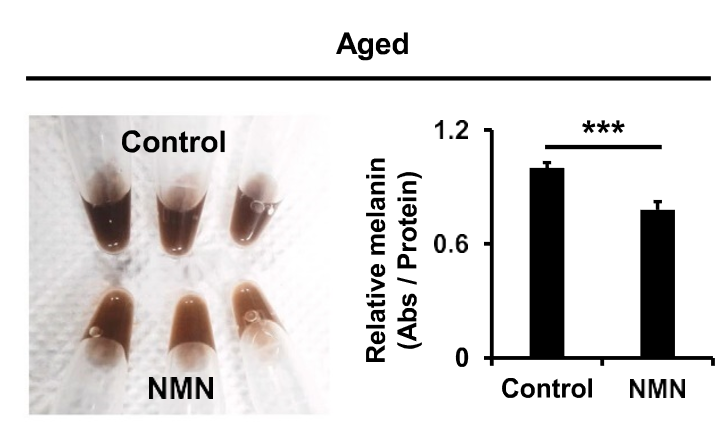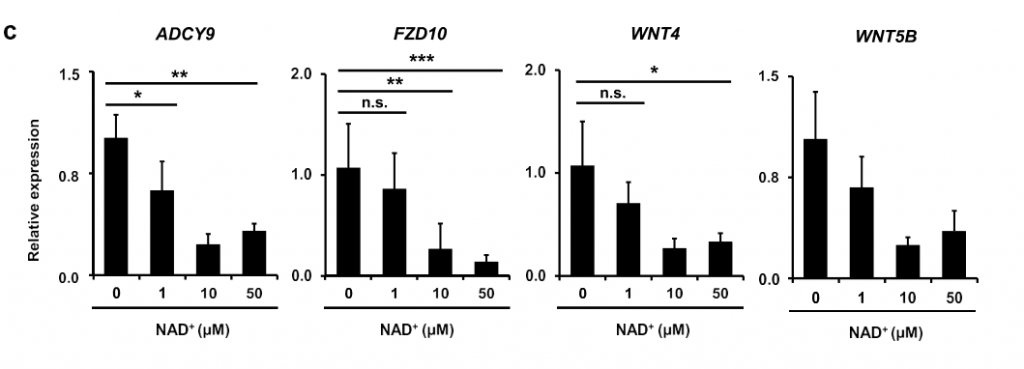

Previous studies have shown that when the skin's physiological function is normal, the skin will slowly metabolize melanin in about 42 days. However, with the increase of age, the imbalance of oxidation and anti-oxidation in cells stimulates the excessive production of melanin in aging melanocytes, making the skin more prone to pigmentation, forming photo freckles and chloasma.
However, a recent study in the "Journal of Dermatological Science" (Journal of Dermatological Science) showed that supplementing NMN can significantly reduce melanin in aging melanocytes by regulating gene expression levels and interfering with cAMP/Wnt signaling in melanin production produce. According to the researchers, "this study provides new ideas for reducing age-induced hyperpigmentation."

In the experiment, the researchers serially subcultured young melanocytes in a dish until the melanocytes stopped dividing. This means that melanocytes lose their ability to divide and enter the aging stage. During this process, the researchers found that the morphology of young melanocytes is regular and has 2-3 branches, but the morphology of aging melanocytes is diverse, with different cell widths and flattening degrees, and cells have multiple branches.

Figure 1 Morphological comparison of young and old melanocytes
Subsequently, the researchers treated the melanocytes with NMN for 3 months, and measured the amount of melanin produced by the melanocytes by spectrophotometry. It was found that the relative content of melanin produced by senescent melanocytes treated with NMN was reduced by about 20% compared with senescent melanocytes not treated with NMN. However, for young melanocytes, there were no significant differences in either short-term or long-term NMN supplementation. This shows that supplementing NMN can reduce the production of melanin in aging melanocytes.

Figure 2 Comparison of the relative content of melanin produced by senescent melanocytes without NMN supplementation and NMN supplementation
To explore the mechanism by which NMN supplementation reduces melanin production, the researchers performed gene expression profiling in NMN-treated senescent melanocytes. It was found that compared with non-NMN-treated senescent melanocytes, the expression levels of 420 genes were increased and the expression levels of 832 genes were decreased in NMN-treated senescent melanocytes. Among them, the genes with increased expression levels are all genes involved in cell proliferation and metabolism, and the genes with decreased expression levels are all related genes involved in melanin production.
In particular, the researchers found that in the cAMP/Wnt pathway, which plays a key role in melanin production, NMN supplementation can significantly reduce the expression levels of "signaling proteins" ADCY5, ADCY9, FZD10, and WNT4. This suggests that NMN supplementation can reduce melanin production by interfering with signaling in the cAMP/Wnt pathway in melanogenesis by regulating gene expression levels.
Among other things, the researchers found that NAD+ levels decreased in aged melanocytes compared with young melanocytes. However, after the aging melanocytes were treated with NMN, their NAD+ levels were significantly increased by more than 50%. In this regard, the researchers tested the inhibitory effect of NAD+ levels on the production of melanin by melanocytes alone.
It was found that increasing the level of NAD+ can reduce the relative content of melanin produced by aging melanocytes; and the expression levels of "signaling proteins" ADCY9, FZD10 and WNT4 in the cAMP/Wnt pathway, which plays a key role in melanin production, decreased. In addition, the higher the NAD+ level, the more pronounced the decrease in the expression levels of signaling proteins.

Figure 3 The expression levels of key proteins in the cAMP/Wnt pathway gradually decreased with the increase of NAD+ level
Our study shows that NMN supplementation can reduce melanin production in senescent melanocytes by interfering with cAMP/Wnt signaling in melanogenesis by modulating gene expression levels. At the same time, increasing NAD+ levels can also achieve the same effect, but whether supplementing NMN achieves this improvement by increasing NAD+ levels is not yet clear. "The researchers said, "However, the effect of supplementing NMN to reduce melanin production is only for aging melanocytes, and this effect does not appear for young melanocytes, which needs to be further analyzed in future studies.
